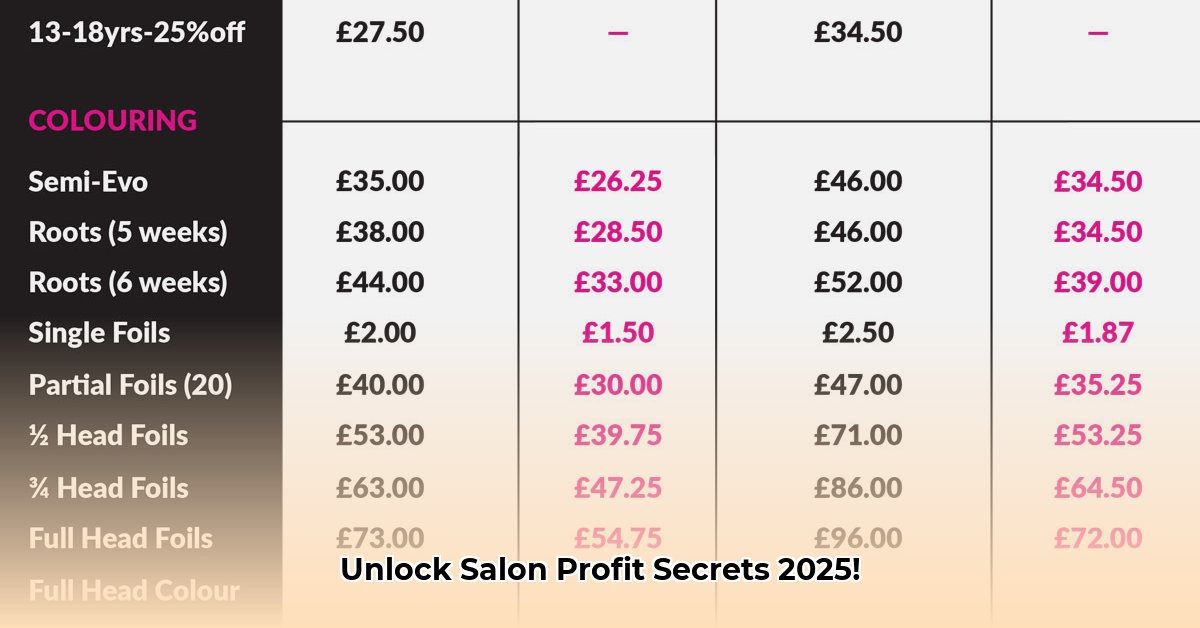Want a thriving hair salon in 2025? It’s not just about amazing haircuts – it’s about smart pricing and cost management. Are you accidentally losing money because your prices are off? This guide will show you exactly how to price your services so you can make more profit and stay ahead of the competition. We’ll walk you through everything from figuring out your costs to setting prices that attract clients and keep your stylists happy. Get ready to boost your salon’s bottom line!
Salon Price List: Your Roadmap to Profitable Pricing in 2025 and Beyond
Want to make your salon a money-making machine with profitable pricing strategies? A smart salon price list is the key. Let’s craft a pricing strategy that attracts clients and fills your bank account.
Understanding Your Costs: Building a Solid Foundation
Before deciding on prices, you need to know exactly where your money goes. What are your regular bills (rent, electricity)? What about costs that change (hair products, staff pay)? Getting a handle on your finances is crucial – it’s like building a house; you need a strong foundation! This is a fundamental pillar of salon financial planning.
Let’s break it down with a simple example:
| Expense Category | Description | Estimated Monthly Cost |
|---|---|---|
| Rent | Monthly lease for your salon space | $2,000 |
| Utilities | Electricity, water, gas, and internet | $700 |
| Products | Shampoos, conditioners, styling products, etc. | $1,200 |
| Staff Wages | Salaries and commissions for your amazing team | $6,500 |
| Marketing | Online ads, social media, local flyers | $300 |
| Insurance & Other Fees | Business insurance, software subscriptions, etc. | $400 |
This detailed breakdown helps figure out your break-even point – the sales you need to cover all your expenses. This process enables you to optimize salon service expenses.
Market Research: The Competitive Landscape
Don’t just copy your neighbors’ prices! Instead, check out what other salons are offering and how much they’re charging. What services are they pushing? What’s their price structure? Who are they targeting? This helps you stand out and find your niche instead of getting lost in the crowd. It’s about understanding the market, not just undercutting everyone. One critical aspect of salon business intelligence is identifying underserved client segments.
Pricing Strategies: Choosing the Right Approach
There are several ways to set prices. Let’s explore some popular options, weighing the pros and cons of each:
1. Tiered Pricing: Offer various packages at different price points. This appeals to a wider range of clients with different budgets. A key benefit of tiered pricing structures is inclusivity.
- Pros: Attracts more clients, creates opportunities to offer more expensive upgrades.
- Cons: More complicated to manage, needs careful planning of what’s included in each package.
2. Value-Based Pricing: Charge based on the perceived value of your services. Top-quality products, skilled stylists, and a luxurious experience all justify higher prices. Applying value-based pricing tactics leverages your salon’s unique selling points.
- Pros: Allows you to charge more for premium services.
- Cons: You need to clearly communicate what makes your salon special and worth the extra cost.
3. À la carte Pricing: Price each service individually. Clients can choose exactly what they want, giving them control. A downfall of using a la carte pricing systems is potential revenue reduction.
- Pros: Total transparency, clients feel empowered.
- Cons: Might lead to lower average spending if not carefully managed. You might need to offer packages to encourage larger purchases.
Building Your Salon Price List: Making it Shine
Creating a professional price list is essential. Have both a printed copy for your salon and an online version for your website and booking system. Consider using booking software that allows for dynamic pricing—adjusting prices based on demand. Clear communication is key – make sure your prices are easy to understand. Ensure that salon price list clarity enhances client satisfaction.
Upselling & Add-ons: Sweetening the Deal
Suggesting extra services, like deep conditioning treatments or styling products, can boost your income. Think of it as offering dessert after a delicious meal – it enhances the whole experience. Frame these extras as value-adds that improve the client’s overall look and feeling! Effective salon upselling techniques significantly impact profitability.
Paying Your Team: Fairness and Motivation
Align your staff’s pay with your different pricing tiers. This motivates them to recommend higher-priced services, benefiting both them and your salon. Fair compensation keeps morale high and your stylists happy! Employee happiness directly correlates with salon staff compensation strategy.
Staying Ahead of the Game: Adapting to Trends
The beauty world changes fast. Trends like eco-friendly products and specialized hair care for diverse hair types are constantly emerging. Keep your finger on the pulse and adapt your services and pricing to stay relevant and competitive. Monitor emerging salon service trends for competitive advantage. Social media platforms like Instagram and TikTok are great resources to identify the styles and services that are trending.
Regularly Reviewing Your Price List: It’s a Living Document!
Remember, your price list isn’t set in stone. It should be reviewed and adjusted regularly to account for changing costs, market conditions, and trends. Regularly evaluate your costs and pricing strategies to optimize your salon’s profitability over time. Keep learning, keep adapting, and you’ll stay ahead of the curve! Regular salon pricing optimization guarantees sustained profitability. Consider reviewing your price list quarterly or bi-annually.
How to Price Hair Salon Services Competitively in 2025
Key Takeaways:
- Accurate cost analysis is fundamental to profitable pricing.
- Competitive market research informs strategic pricing decisions.
- Selecting the right pricing model (tiered, value-based, à la carte, or dynamic) is crucial.
- Effective communication of pricing to clients is essential.
- Upselling and add-on services boost revenue.
- Fair compensation structures motivate stylists.
- Adapting to trends (sustainability, specialized services) ensures long-term success.
Understanding Your Costs: The Foundation of Profitable Pricing
Before you even think about what your competitors charge, you need to know your own numbers. This involves a thorough analysis of both fixed and variable costs. Fixed costs remain consistent (rent, utilities, staff salaries). Variable costs fluctuate (products, commissions). A simple calculation – total costs divided by the number of services, multiplied by your desired profit margin – provides your base price. But remember, this is just a starting point. Calculating salon cost analysis metrics provides a solid pricing foundation.
Think of it like baking a cake: You need the right ingredients (costs) in the correct proportions to get a delicious outcome (profit). Be meticulous in tracking every expense, no matter how small. Even seemingly insignificant costs can add up and impact your bottom line.
Market Research: Navigating the Competitive Landscape
Don’t just blindly copy your rivals. Instead, conduct thorough market research. This includes analyzing competitor prices, service offerings, target demographics, and overall market positioning. Secret shopping, online reviews, and even just browsing competitors’ websites provide valuable data. Remember, you’re not copying; you’re learning. You’re understanding your place in the market. Salon competitor analysis insights are key to differentiation.
What are their strengths and weaknesses? What niche are they filling? How can you differentiate your salon? Consider factors like location, salon ambiance, stylist expertise, and customer service.
Pricing Strategies: Finding the Right Fit for Your Salon
Several pricing models exist. Each has its own set of pros and cons.
1. Tiered Pricing: This model prices services based on stylist experience levels. Junior stylists charge less than senior stylists, who in turn charge less than master stylists. This system is transparent and fair to both stylists and clients. Effectively using salon tiered pricing examples helps diverse client budgets.
- Pros: Simple to understand, fair compensation, caters to different budgets, provides opportunities for clients to “level up” as their budget allows.
- Cons: Requires careful management of stylist skill levels, potential for client confusion if not well-explained, can be challenging to implement if stylist skill levels aren’t clearly defined.
2. Value-Based Pricing: This emphasizes the value of your services rather than simply the cost of materials and labor. It focuses on the results and experience clients receive. It leverages the expertise and experience of your stylists. Salon value based pricing benefits premium service offerings.
- Pros: Justifies premium pricing, attracts clients valuing quality over price, enhances brand image, increases profitability per service.
- Cons: Requires strong brand building and marketing to convey value, may deter budget-conscious clients, relies heavily on consistent service excellence.
3. À la Carte Pricing: Individual services are priced separately, allowing clients to customize their appointments. Maintaining salon a la carte pricing structures promotes transparency.
- Pros: Flexibility, client control, transparency, allows clients to tailor their experience to their specific needs and budget.
- Cons: Can be complex to manage, potential for lower profit margins if not managed correctly
- Glass Wall Tile Ideas for Kitchens and Bathrooms - December 6, 2025
- Glass Tile Bathroom: Create a Beautiful, Easy-Clean Space - December 5, 2025
- Glass Tile: Brighten Your Home With Stylish Glass Backsplashes - December 3, 2025










